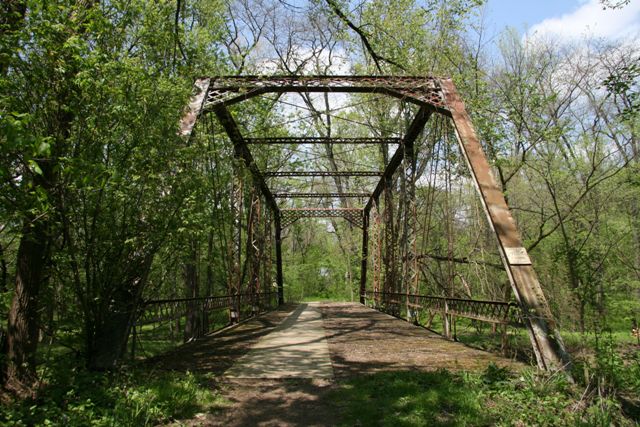We Recommend:
Bach Steel - Experts at historic truss bridge restoration.
BridgeHunter.com Phase 1 is released to the public! - Visit Now
Precht Bridge

Primary Photographer(s): Rick McOmber
Bridge Documented: May 4, 2008
Rural: Henry County, Ohio: United States
By Builder/Contractor: Massillon Bridge Company of Massillon, Ohio
Not Available or Not Applicable
Not Available
Not Available
Not Available
1 Main Span(s)
35XXXX1

View Information About HSR Ratings
Bridge Documentation
This bridge no longer exists!
This six panel through truss bridge stylistically appears to be the work of Massillon Bridge Company. The name for the bridge comes from a relatively new plaque on the bridge commemorating William Precht who died at this bridge in a tractor accident. The bridge is located within a state park and although the bridge is not restored and on an undeveloped trail, it remains open for pedestrian and horse traffic.
Information and Findings From Ohio's Historic Bridge InventorySetting/Context The bridge, which is closed to traffic, provides access to the rural Showman-Edward Cemetery in Mary Jane Thurston State Park. It is open to pedestrians. Physical Description The 1 span, pin-connected Pratt thru truss bridge is traditionally composed of built-up compression members and eyebar or rod tension members. The upper chords are toe-out channels with cover plates and lacing. The verticals are toe-out-channels with lacing. The bridge has lattice portals, and upper lateral bracing of angles with lacing. Rolled floorbeams are supported from the lower-chord pins by U-shaped hangers. The bridge has rolled stringers and wood deck. There are lattice railings. The abutments are ashlar. Integrity Some loss of original fabric from metal-related deterioration. Summary of Significance The ca. 1906 pin-connected Pratt thru-truss bridge is a later example of its type/design with no distinguishing features or details. It is attributed to the Massillon Bridge Company of Massillon, Ohio, based on
its similarity to 24xxxx1, a documented example from 1906. In comparison to the population, the bridge is not distinguished by its history or technology. Bridge Considered Historic By Survey: No |
![]()
Photo Galleries and Videos: Precht Bridge
Bridge Photo-Documentation
Original / Full Size PhotosA collection of overview and detail photos. This gallery offers photos in the highest available resolution and file size in a touch-friendly popup viewer.
Alternatively, Browse Without Using Viewer
![]()
Bridge Photo-Documentation
Mobile Optimized PhotosA collection of overview and detail photos. This gallery features data-friendly, fast-loading photos in a touch-friendly popup viewer.
Alternatively, Browse Without Using Viewer
![]()
Maps and Links: Precht Bridge
This historic bridge has been demolished. This map is shown for reference purposes only.
Coordinates (Latitude, Longitude):
Search For Additional Bridge Listings:
Bridgehunter.com: View listed bridges within 0.5 miles (0.8 kilometers) of this bridge.
Bridgehunter.com: View listed bridges within 10 miles (16 kilometers) of this bridge.
Additional Maps:
Google Streetview (If Available)
GeoHack (Additional Links and Coordinates)
Apple Maps (Via DuckDuckGo Search)
Apple Maps (Apple devices only)
Android: Open Location In Your Map or GPS App
Flickr Gallery (Find Nearby Photos)
Wikimedia Commons (Find Nearby Photos)
Directions Via Sygic For Android
Directions Via Sygic For iOS and Android Dolphin Browser
USGS National Map (United States Only)
Historical USGS Topo Maps (United States Only)
Historic Aerials (United States Only)
CalTopo Maps (United States Only)

